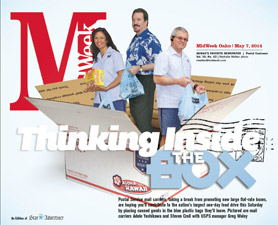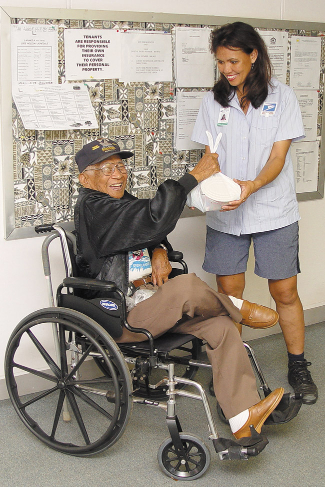Thinking Inside The Box
“It’s considered mail,” adds Croll.
The blue bags reach each residential home thanks to sponsors Hawaii State AFLCIO, McDonald’s Hawaii, Menehune Water Company and Honolulu Freight Service.
According to Yoshikawa, the inclusion of the blue bags greatly increased donations (the numbers tripled), and along with the bags little food drive cards are included.
mw-cover-050714-usps-5
There was a push for changing the bag’s color from blue to green, to go along with the “going green” movement, but Yoshikawa said blue bags are so significant to the effort.
“That’s why we wanted to keep the blue bags, but we still follow the rules,” Yoshikawa says of the biodegradable bags.
The top-five food items of greatest need are protein items such as Vienna sausage and Spam, prepared meals like stews and types of chili, canned fruits, canned vegetables and bags of rice.
Who knew that a common activity could help those less fortunate in our community? Take that short walk to your mailbox with your blue bag filled with canned goods for Hawaii Foodbank and help feed Hawaii’s hungry. It’s that simple.
“We encourage people to fill the bag,” Yoshikawa urges.
And if the bag doesn’t fit in the mailbox, you can hang it outside. If it is not big enough to fit all your donations, Yoshikawa encourages those donating to leave boxes of donations in a hidden place with a note for the mail carrier as to their whereabouts.
“No hassle,” she explains. “We tell everyone that this is the easiest drive.”
Filling the bags is something that Yoshikawa describes as kid-friendly.
“They love doing it!” she says. “The kids take home fliers and they say, ‘Mom, do you know we have to fill our blue bag for the food drive?'”
Croll adds that keiki love the Family Circle cartoon on the event’s banner, which was created by Woolley Brothers Screen Printing in Waialua.
“It also gives them a sense of participation,” he adds, “because they say ‘Let’s give them this, let’s give them that.'”
But these mail carriers do much more than just deliver mail.
“We’re out there in the community,” Yoshikawa says.
The NALC Carrier Alert Program allows mail carriers to work with residents and local law enforcement to monitor their communities.
“We visit the homes every day,” Yoshikawa adds. “If we see something that’s not right, we’ve been able to save lives.”
Croll says they have worked with the police and fire departments.
“Maybe they’re looking for a fire somebody reported but didn’t give a location,” he explains. “If there’s something that’s unusual, a lot of times we’ll notice something. It’s our chance to give back, and it’s a way for us to be part of our community and part of our neighborhoods.”
The focus on community and keeping things local also is apparent in Stamp Out Hunger.
“Because we’re detached from the Mainland, people like the idea of ‘buy local,’ and they also like the ‘do local,'” Croll says.
There are aspects of Stamp Out Hunger that Mainland groups want our local carriers to try, but Croll says they try to resist a little.
“It’s because we want our local ideas, because they work here,” he adds. “They like to feel like this is our community, too, and we want to give back to the people in need in our community.”
Yoshikawa and Croll have high hopes for this year’s drive, and are grateful for all the hard work their fellow mail carriers have put in.
“Our goal is to always beat the previous year,” Yoshikawa says as she pumps her fist in the air. “We want to go beyond last year!”







